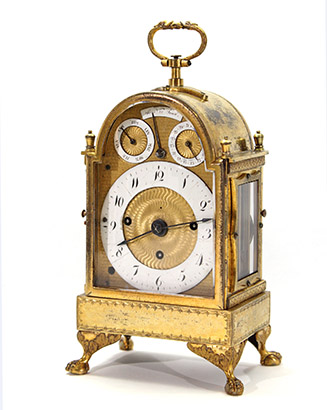Grande Sonnerie Pendule d’Officier, by Schmidt of Prag

A grande sonnerie travelling clock dating from the turn of the 19th century, by Schmidt of Prag(ue). This clock has calendar-work rarely seen on clocks of this description. The calendar-work is all complete and functioning.
The small break arch case retains much of its original gilding. It is surmounted by a snake handle with a central strike repeat button. The case panels have engraved borders, the back door and side panels are glazed. The whole is raised on a plinth base with cast claw and ball feet.
The 3¼-inch engine turned gilt brass dial has a white enamel Arabic chapter ring beneath subsidiary day of the week (French) and date dials and a strike/silent dial, inscribed Sonn’ / Ne Sonn’ .
The three train 30-hour movement has a chain fusee going train and two spring barrel strike trains. The verge balance escapement has a beautifully fretted and engraved balance cock.
The polished steel grande sonnerie strike work is mounted between the front-plate and the dial. The movement is stamped ‘Schmidt, Prag’ to the lower edge of the frontplate.
It is Viennese grand sonnerie striking, that is to say it strikes the hour and the quarters on two bells mounted vertically on the backplate.
- Height: 8 inches (20.5cm)
- Width: 4½ inches(11cms)
- Depth: 3¼ inches (8cms)